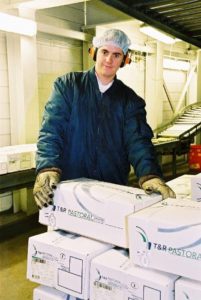Personal Protective Equipment
What are the requirements related to personal protective equipment (PPE) ?
According to the National Guidelines for Health and Safety in the Meat Industry:
‘ PPE and clothing are those items of equipment worn by an employee to minimise or eliminate exposure to specific occupational hazards’
The emphasis is always on eliminating the hazards thereby making it unnecessary for workers to wear Personal Protective Equipment (PPE). However, it is not always possible to eliminate the hazards, and PPE may be required to protect the worker from the consequences of exposure. For example, workers may be required to wear hearing protection to reduce the likelihood of hearing loss resulting from exposure to an excessively noisy environment. Workers in the meat industry are frequently required to wear PPE. In this case it is the employer’s responsibility to ensure PPE is:
- assigned to the worker for their exclusive use
- cleaned and maintained after use
- stored when not in use
- inspected and repaired regularly
- checked for continued functioning and effectiveness.
It is also the employer’s responsibility to ensure training is provided as appropriate. Workers should receive training about:
- proper use of PPE
- the deficiencies and restrictions of PPE
- fitting PPE and how to test for fit
- use of PPE
- maintenance of PPE
- storage of PPE
- identification of faults in PPE
- procedure for replacing PPE.
Workers are responsible to:
- wear PPE as instructed by the supervisor and as set out in the work instruction
- fit PPE to ensure it is used to maximum benefit
- check for any faults and replace it if faulty
- follow maintenance procedures as instructed by the supervisor and set out in work instructions
- store PPE as instructed.

Worker wearing clothing for cold room
Courtesy of Meat and Livestock Australia
Accident Management
What is an accident?
An accident is any event that results in:
- injury or illness to a person
- damage to property.
What is an incident?
An incident is when the same event occurs but there was no injury or damage. Incidents may be described as ‘near misses’. Incidents are warning signs and indicate an accident may happen. This is why incidents are reported in addition to accidents.
What happens after an accident or incident?
All incidents/ accidents must be reported to supervisors and an investigation conducted as soon as possible to identify and rectify factors that may have contributed to the accident. In addition, WHS legislation requires the reporting of serious accidents (that result in hospitalisation of an injured worker) to the relevant WHS authority.
Following an accident:
- first aid and medical assistance is provided to the injured person as appropriate
- any faulty equipment or machinery should be tagged and locked out
- the accident or incident report form should be filled in
- an investigation into the factors contributing to the accident should be conducted
- control measures identified and implemented to rectify the factors contributing to the incident/accident.
In cases of serious injury or death, inspectors from the relevant government WHS regulatory authority will conduct an investigation.
The goal of accident or incident investigation is to identify the factors that may have contributed to the accident, and put in place appropriate controls so the accident will not happen again.
What is the workers role after an accident?
